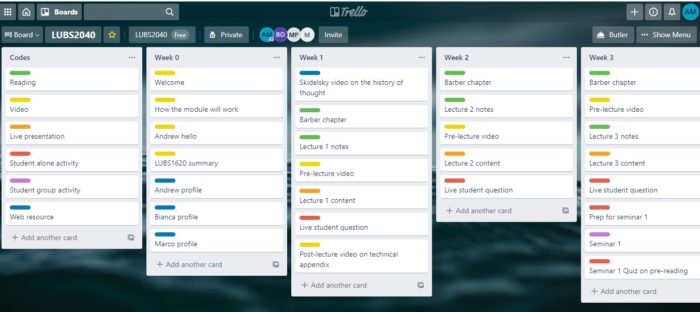Re-design: online delivery, assessment and aligning the two
This example considers how moving a second-year economics module online involved a series of changes, to delivery, ‘lecture’ and seminar content, and to assessment. Here the focus lies particularly on how the assessment was changed and how the module delivery was redesigned to align with it. We might call it reconstructive alignment.

What did you do? Why did you do it?
The case in question is a second-year economics module with approximately 200 students enrolled. We flipped delivery, combining short introductory videos with a live presentation of content, always allowing a sizeable chunk of time for Q&A. We also held a mixture of virtual and physical seminars. The purpose of these synchronous events was as much social-psychological as for learning. The module team found using a Trello module planner helpful with collaboration. For instance, the ease of copying the weekly cards facilitated a consistent structure, while helping to visualise the balance of activities through colour coding.
Previously, the module was assessed by asking students to write three essays in two hours, an approach that had typically produced competent answers that expertly reproduced class material. So, change was needed anyway. We moved to a 48-hour exam, now asking students to write two medium-length (500 words) answers plus a longer one (1500 words) on an applied topic. We introduced word length guidance, designed to dissuade students from writing long essays; and stressed the need for paraphrasing and finding their own material.
To support this, recognising that there were no past papers to go on, we redesigned the seminars to rehearse the type of exam questions students would get. As standard, we provided a mock exam with extensive direction on how students might approach it, and how to meet each of the assessment criteria. We created guidance videos – in the style of others used earlier in the module – one on the technical constraints of the exam, the other on how to revise. Here we stressed that revision for the exam was not about memorisation but preparation and organisation. We also offered advice about how to use the 48 hours – including the suggestion to leave the material alone overnight and come back to it. Finally, a set of Padlets allowed anonymous questions about the exam and about each block of module content.
What was the impact of your practice and how have you evaluated it?
The module evaluation questionnaire responses are generally positive – students particularly appreciated the opportunity to attend live events, for the structure it gave them. In terms of the assessment, we await the exam submissions. A successful outcome would be good average performance on the exam plus an increased proportion of high marks. We also hope to see no increase in the incidence of academic integrity referrals.
How could others benefit from this example?
Nothing here is particularly radical. The main message is to accept that this time it was different. Thinking first about the assessment has helped drive other elements of the module so that encounters with students were considered afresh.
Author: Andrew Mearman, a.j.mearman@leeds.ac.uk, Economics
Do you have an example of your practice to share?
If you are interested in submitting an article to the TIPS Blog find out how to submit here, or contact the TIPS Editors at academicdev@leeds.ac.uk.
